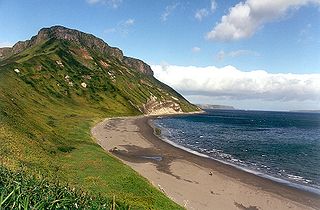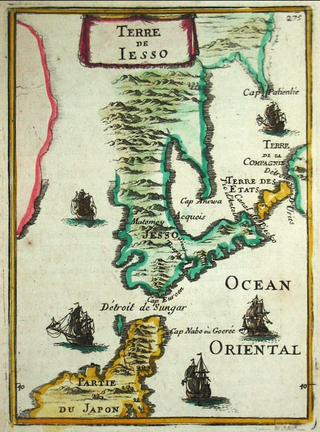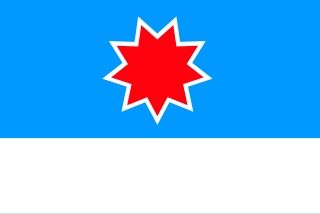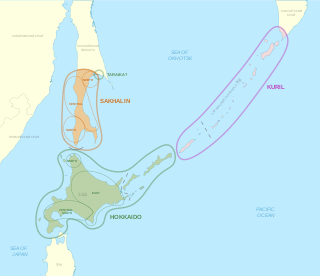Related Research Articles

The Ainu are an ethnic group of related indigenous peoples native to northern Japan, including Hokkaido and Northeast Honshu, as well as the land surrounding the Sea of Okhotsk, such as Sakhalin, the Kuril Islands, the Kamchatka Peninsula, and the Khabarovsk Krai; they have occupied these areas known to them as "Ainu Mosir", since before the arrival of the modern Japanese and Russians. These regions are often referred to as Ezo (蝦夷) in historical Japanese texts.

Sakhalin is an elongated island in Northeast Asia, located just 6.5 km (4.0 mi) off the southeastern coast of Khabarovsk Krai in Russia, and 40 kilometres (25 mi) north of Japan's Hokkaido. A marginal island of the West Pacific, Sakhalin divides the Sea of Okhotsk to its east from the Sea of Japan to its southwest. It is administered as part of Sakhalin Oblast and is the largest island of Russia, with an area of 72,492 square kilometres (27,989 sq mi). The island has a population of roughly 500,000, the majority of whom are Russians. The indigenous peoples of the island are the Ainu, Oroks, and Nivkhs, who are now present in very small numbers.

The Kuril Islands or Kurile Islands are a volcanic archipelago administered as part of Sakhalin Oblast in the Russian Far East. The islands stretch approximately 1,300 km (810 mi) northeast from Hokkaido in Japan to Kamchatka Peninsula in Russia, separating the Sea of Okhotsk from the north Pacific Ocean. There are 56 islands and many minor islets. The Kuril Islands consist of the Greater Kuril Chain and, at the southwest end, the parallel Lesser Kuril Chain. They cover an area of around 10,503.2 square kilometres (4,055.3 sq mi), with a population of roughly 20,000.

Ezo (蝦夷) is the Japanese term historically used to refer to the people and the lands to the northeast of the Japanese island of Honshu. This included the northern Japanese island of Hokkaido, which changed its name from "Ezo" to "Hokkaidō" in 1869, and sometimes included Sakhalin and the Kuril Islands. The word Ezo means "the land of the barbarians" in Japanese.

Karafuto Agency, from 1943 Karafuto Prefecture, commonly known as South Sakhalin, was a colony of the Empire of Japan on Sakhalin from 1907 to 1943 and later a prefecture until 1945.

Ainu music is the musical tradition of the Ainu people of northern Japan. Ainu people have no indigenous system of writing, and so have traditionally inherited the folklore and the laws of their culture orally, often through music.

Ainu, or more precisely Hokkaido Ainu, is a language spoken by a few elderly members of the Ainu people on the northern Japanese island of Hokkaido. It is a member of the Ainu language family, itself considered a language family isolate with no academic consensus of origin. It is classified as Critically Endangered by the UNESCO Atlas of the World's Languages in Danger.

Oroks, sometimes called Uilta, are a people in the Sakhalin Oblast in Russia. The Orok language belongs to the Southern group of the Tungusic language family. According to the 2002 Russian census, there were 346 Oroks living in Northern Sakhalin by the Okhotsk Sea and Southern Sakhalin in the district by the city of Poronaysk. According to the 2010 census there were 295 Oroks in Russia.
The tonkori (トンコリ) is a plucked string instrument played by the Ainu people of Hokkaidō, northern Japan and Sakhalin. It generally has five strings, which are not stopped or fretted but simply played "open". The instrument is believed to have been developed in Sakhalin. By the 1970s the instrument was practically extinct, but is experiencing a revival along with the increased interest in Ainu heritage.

Sakhalin Koreans are Russian citizens and residents of Korean descent living on Sakhalin Island, who can trace their roots to the immigrants from the Gyeongsang and Jeolla provinces of Korea during the late 1930s and early 1940s, the latter half of the Japanese colonial era.
A kamuy is a spiritual or divine being in Ainu mythology, a term denoting a supernatural entity composed of or possessing spiritual energy.

The territorial conquests of the Empire of Japan in the Western Pacific Ocean and East Asia began in 1895 with its victory over Qing China in the First Sino-Japanese War. Subsequent victories over the Russian Empire and German Empire expanded Japanese rule to Taiwan, Korea, Micronesia, southern Sakhalin, several concessions in China, and the South Manchuria Railway. In 1931, Japan invaded Manchuria, resulting in the establishment of the puppet state of Manchukuo the following year; thereafter, Japan adopted a policy of founding and supporting puppet states in conquered regions. These conquered territories became the basis for the Greater East Asia Co-Prosperity Sphere in 1940.

The Ainu creation myths are the traditional creation accounts of the Ainu peoples of Japan. Their stories share common characteristics with Japanese creation myths and earth diver creation stories commonly found in Central Asian and Native American cultures. Ainu mythology divides time into three tenses: "Mosir sikah ohta", "mosir noskekehe", and "mosir kes". In one version, the creator deity sends down a water wagtail to create habitable land in the watery world below. The little bird fluttered over the waters, splashing water aside, and then he packed patches of the earth firm by stomping them with his feet and beating them with his tail. In this way, islands where the Ainu were later to live were raised to float upon the ocean.

Archdeacon John Batchelor, D.D., OBE was an Anglican English missionary to the Ainu people of Japan until 1941. First sent under the auspices of the Church Missionary Society of the Church of England, Batchelor lived from 1877 to 1941 among the indigenous Ainu communities in the northern Japanese island of Hokkaido. He was a charismatic and iconoclastic missionary for the Anglican Church in Japan and published highly regarded work on the language and culture of the Ainu people. Batchelor only reluctantly left Japan at the outbreak of the Second World War in the Pacific in 1941.

The Ainu in Russia are an Indigenous people of Siberia located in Sakhalin Oblast, Khabarovsk Krai and Kamchatka Krai. The Russian Ainu people, also called Kurile, Kamchatka's Kurile or Eine, can be subdivided into six groups.

This is a bibliography of works on the Ainu people of modern Japan and the Russian Far East.
Sakhalin Ainu is an extinct Ainu language, or perhaps several Ainu languages, that was or were spoken on the island of Sakhalin, now part of Russia.

The Hokkaidō Development Commission, sometimes referred to as Hokkaidō Colonization Office or simply Kaitakushi, was a government agency in early Meiji Japan. Tasked with the administration, economic development, and securing of the northern frontier in what, at the time of establishment, was known as Ezo, it was established in 1869 and disbanded in 1882.

The Ainu languages, sometimes known as Ainuic, are a small language family, often regarded as a language isolate, historically spoken by the Ainu people of northern Japan and neighboring islands.
Ainu culture is the culture of the Ainu people, from around the 13th century to the present. Today, most Ainu people live a life superficially similar to that of mainstream Japanese people, partly due to cultural assimilation. However, while some people conceal or downplay their Ainu identity, Ainu culture is still retained among many groups. The Ainu way of life is called Ainupuri in the Ainu language. The unique Ainu patterns and oral literature have been selected as features of Hokkaido Heritage.
References
- ↑ Batchelor, John (1901). The Ainu and Their Folk-lore. Religious Tract Society. p. 273.
- ↑ Batchelor, John (1892). The Ainu of Japan: The Religion, Superstitions, and General History of the Hairy Aborigines of Japan. Religious Tract Society. p. 129.